WILLIAM J. KOLOMYJEC
THE APPEAL OF COMPUTER GRAPHICS
My interest in computer graphics began while I was an undergraduate working toward my Bachelor of Fine Arts degree in Industrial Design. I.D. concerns itself primarily with product aesthetics. I discovered when doing product design that many things could be quantified, including Man,1 and that products might suit more people if they could be adapted or adjusted to individual needs. It became apparent to me that a computer which held the relevant data about a consumer could, during production, 'customize' an item and make it more desirable. This led me to further research culminating in a Master of Fine Arts degree in Graphic Design. This was unique in the fact that the majority of my endeavor was in 'Computer Graphics' making me the first 'computer graphic artist' to graduate from Michigan State University and, no doubt, one of the few Fine Arts people to have a minor in Computer Science.
During my investigations, I found a book with the dubious title, Design and Planning 2.2 The book was largely based on contributions to the '1966 International Conference on Design and Planning' at the University of Waterloo, Waterloo, Ontario. It dealt with conceivable uses of the computer as a design 'tool' and gave specific to general explanations of design applications and possible design applications. For the first time the many nuances and ramifications associated with computer aided design were revealed to me. The appeal was so great that I had to investigate its use further and I have been involved with that investigation ever since.
The digital computer and peripheral graphic equipment (scopes, plotters, etc.) comprise my medium. I consider these things to be my tools and, as a Computer Graphic Artist, I must translate my imagery and desires into a form that can be used by this hardware. The medium is as complete and valid as any traditional aesthetic media be it painting, lithography, ceramics, photography or any other media. There are several strong similarities within computer graphics to these established media. Photography relies upon much specialized equipment in the total photographic process (i.e., from when the photographer composes or takes the picture to when the final image is printed and displayed). Computer graphics requires even more complicated and specialized equipment in its process of making computer imagery. Different configurations of computer and graphic equipment change output (the final form in which imagery is presented) and its similarity to other media. For example, with a plotter or hard copy unit, the medium should be considered as 'printmaking.' When a computer and a digagraphic display console with refresh capabilities are joined, computer graphics can be considered as cinematography. One final example would be three dimensional output. A computer and a numerically controlled machine, such as a milling machine, could produce a form of output which, for all practical purposes, would be sculpture.
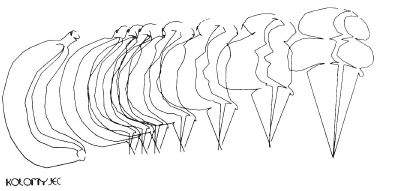
The imagery of computer graphics can essentially be put into one of two categories with the possibility of having various ratios of these present in the final visual statement. The first category is the 'digitized image' where an image, be it representational or non-representational, is provided as data to the computer external to a computer program. The second method of supplying computer imagery is by means of algorithms, or internally as part of the computer program. The random number generator falls within this category. In my visual statements I employ both types of imagery. It usually depends on what I am trying to say or what I wish to explore that determines the method I use. When I have a specific representational image in mind, I use the first method and digitize the image. However, there are cases when the image, like a star or regular polygon, is more suited to an algorithm. In 'Banana-Cone,' figure 1, the key images of the banana and the ice-cream cone had to be digitized. Each image has 99 digitized coordinate locations and appropriate pen controls for lifting the pen at proper line segments. The imagery originates from one of my wife's favorite treats, banana ice cream. That part of the process that takes an image between conception and symbolic representation is purely subjective and may come from many sources or personal experiences. It may also be a study of another work as I will explain later. As bananas can be made into ice cream to be consumed as food, it is possible to change the form of a banana using a linear interpolation into that of an ice cream cone which may be visually consumed again and again. If nothing else, the aesthetic method has less calories.
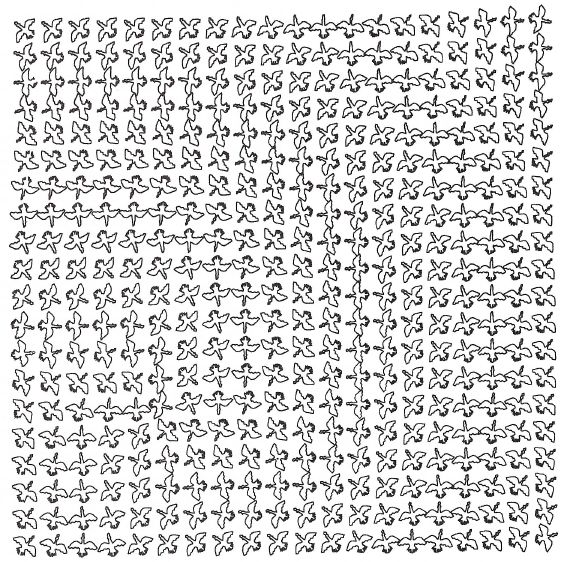
Other examples of using data bases of imagery external to a computer program are 'Birds,' figure 2, 'Bird Curves,' figure 3, and 'Creature Tunnel,' figure 4. These works are particularly good illustrations of one of the things that a computer does so well since the computer is very good at performing repetitious operations. These programs use the same data over and over again with slight modifications. To have done these without the aid of a computer would have been too laborious and the quality of drawing would not have been as precise. I have put together a data base of four animals each having the same number of points and pen controls. From this menagerie I can select at will any, or all, of my creatures for use in a program.
Primarily I write my own FORTRAN programs. I feel it is necessary that a 'computer artist' do this. I consider myself a 'user' as far as the computer production hierarchy is concerned but I am neither an engineer nor computer scientist. Another thing I am not is a mathematician, but I sometimes work with one to help in writing complex algorithms such as determining the orientation of my imagery in 'Birds' and 'Bird Curves.' From writing general algorithms it is possible to piece them together as segments to make up other programs like 'Creature Tunnel' that does use several things including the total menagerie as its data. This program employs the random number generator to make decisions as to choice of animal, its position, and amount of rotation on a spatial cylinder. Finally all these things are put into perspective which can be varied and thus determine the final imagery. All in all, with so many options and combinations which comprise a program, the decisions which a computer graphic artist makes to yield a particular final image are identical to the decisions made by any other artists working in any other media.
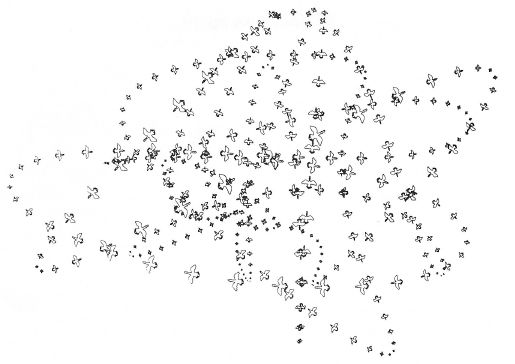
figure 3: 'Bird Curves'.

figure 4: 'Creature Tunnel'.
The algorithmic method, or method of creating an image internal to a program provides imagery with a different quality. 'Random Concentric Squares,' figure 5, contains an algorithm that can divide an individual square within a larger array of squares into a random number of concentric squares based on the random location of a square with a fixed size located anywhere within its boundaries. 'Organic Illusion,' figure 6, uses the same basic idea of a large array of squares. However, its algorithm places a circle randomly with one square and equally randomly connects points to the extremities of that square. Note here that the points on the extremities of adjacent squares are coincidental and give a concrete overall structure to the work. 'Kolomyjec's Moire,' figure 7, deals with the optical phenomena produced by moire patterns. Considered as a group, these works have a similar quality about them yet they are dissimilar to the group of previous works. Using these works as examples, the distinction of these categories of computer graphic imagery become further apparent.
In my explorations dealing with computer graphics, I will, at times, attempt to interpret works of other artists. Just as all art students are impressed by works they have seen in the course of their studies, I too have been impressed. I enjoy making images that not only reveal the attributes of my medium but also exude the essence of those which I study. Figure 7, 'Kolomyjec's Moire' not only illustrates the logic of many branching-search algorithms used in computer science by computer scientists, it also may be classified 'Optical Art' and contains visual phenomena akin to that which an 'Op'-artist might produce. If we were to look at the works of the 'Op'-artists, particularly Richard Anuszkiewicz, Bridget Riley, and Victor Vasarely, one might be surprised with their similarity to computer generated images. Figure 2, 'Birds,' is a single image repeated over and over like Andy Warhol's coke bottles, soup cans, dollar bills, whatever. Yet I do not attempt to bring myself down to the level of the machine like Warhol, but rather try to bring the machine up to my level. I use more than just its ability to do repetitious operations, I also create a dynamic structure. There are other examples, however, I would like to point out a final one. A man who has been an unquestionable source of inspiration to me is Maurits C. Escher. The manner in which Escher derives imagery is so clear-cut and methodical that they seem almost algorithmic in nature. There is an excellent article about Escher in one issue of Scientific American magazine3 that attributes his sources primarily to experiments on visual perception. Some of the techniques he utilized were naturals for computer imagery. His transformations of one image into another, 'Metamorphose,' 1939-40, compares with linear or parabolic interpolation similar to figure 1. His ambiguous limits of large and small, 'Square Limit,' 1964 and 'Circle Limit IV,' 1960, sometimes referred to as 'Heaven and Hell,' form interlocking structures of shapes while they increase or decrease in size and were my sources for two series of works: 'Homage to Maurits C. Escher' figure 8, which is the second from this series, and 'Escher in the Round' figure 9, which is the third from this series.
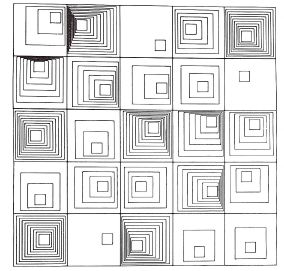
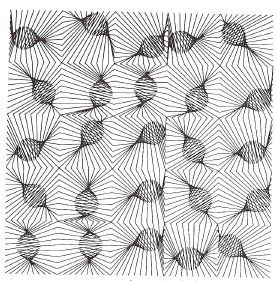
It is interesting to note that computer graphics as a 'fine art' had its first showing only ten years ago. In 1965 exhibitions of computer generated art forms took place in America and Europe.4 The Americans were A. Michael Noll and Bela Julesz. Their European counterparts were Frieder Nake and George Nees. It was not uncommon for these early computer image makers to use the computer to duplicate a basic theme by a traditional artist. A classic study is by A. Michael Noll, 'Computer Compositions with Lines' 1965, after Peit Mondrian's 'Composition with Lines,' 19175 Figure 10, 'Boxes' in turn is my interpretation of a work by George Nees entitled 'Gravel Stones.'6 I feel that it is appropriate to study works of other artists, especially traditional artists and those who established computer art in the fine art realm.
The computer has been labeled 'the ultimate creative tool for the artist-engineer-scientist.'7 Computer graphics has the distinction that it allows an exchange between artist and engineer-scientist. The artist must work hard to learn the objective approach to problem solving, the engineer-scientist must acquire visual sensitivity and awareness. In a mutual setting, such as a classroom, both may exchange ideas but each must use whatever creativity he or she may possess to solve problems and produce computer graphics. Computer graphics exploits this creative potential in both artist and engineer-scientist. The trend in recent years in art has been towards a collaboration of art and technology. Its roots lie in the Dadaist philosophy to alleviate the 'unrestrained individualism' of the artist. There have been many cases in art since 1900 where artists have 'physically and intellectually collaborated with new technology. '8 The appeal of the machine has been overwhelming since the advent of electronics and electronic control. This is one reason why artists and engineer-scientists have gyrated closer and closer together. "...art as a whole (has moved) from depiction of movement to movement itself, from programming interface with the computer to the actual computer, from a lust for life to an involvement with it."9 There is no question in my mind that art and technology have become willing partners and shall continue to influence each other in future. Computer art is a logical end in this involvement. Just exactly how it will affect art in the future remains to be seen. Yet there are some ramifications. It is possible to use a computer to generate unlimited unique multiples from one 'superoriginal.' I can provide prints of figures 3, 4, 5, 6 and 10, each an original in its own right since each has the random number function built into its respective program. But some questions do arise. Is mass production of art by the computer the method to make art available to everyone? When produced in quantity, does the value as well as the price of art work decline? Are people willing to accept and support the computer as an instrument that can, under the control of an artist, be a valid form of individual expression?


figure 8: 'Homage to Maurits C. Escher'.

figure 9: 'Escher in the Round'.
As long as I can attain access to a computer I will continue to use it. It is my medium! Here at Michigan State University I have taught computer graphics as a form of expression for the past two years and the response has been overwhelming. Many art students, after an involvement with the computer, discover that there are objective methods to problem solving and any preconceived notions about the 'ominous' computer are dispelled, it becomes a tool in their hands. Many non-art students when they become acquainted with visual phenomena learn to 'see' their world under a different light. I encourage my students to work together in debugging programs and evaluating imagery. All take part in classroom critiques. Here the collaboration reaches a maximum when artist and non-artist explain what thoughts underlie a particular work. The effort in making computer graphics is great but then so is the reward. I encourage anyone to spend the time and effort necessary in one's involvement with this medium. Perhaps the greatest return comes from the works themselves when the neophyte computer artists discover that embedded in their imagery is a little of themselves.

East Lansing, Michigan
September 1975
REFERENCES
1. The Measure of Man, Henry Dreyfus, Second Edition, Published by Whitney Library of Design, 1959.
2. Design and Planning 2, Edited by Martin Frampen and Peter Sietz, Hastings House, Publishers, Inc., N.Y., 1967.
3. "Sources of Ambiguity in the Prints of Maurits C. Escher," by Marianne L. Teuber, from Scientific American Magazine, Volume 231, Number 1, July 1974.
4. Art in the Future, A History/Prophecy of the Collaboration between Science, Technology and Art, by Douglas Davis, Praeger Publishers, 1973, p. 99.
5. Computer Graphics—Computer Art, H.W. Franke, Phaidon Press Ltd., London, 1971, p. 111, fig. 91.
6. Ibid p. 30, fig. 20.
7. Art in the Future, A History/Prophecy of the Collaboration between Science, Technology and Art, by Douglas Davis, Praeger Publishers, 1973, p. 97.
8. Ibid, p. 112.
9. Ibid, p. 112.
Return to Table of Contents | Previous Section | Next Section

